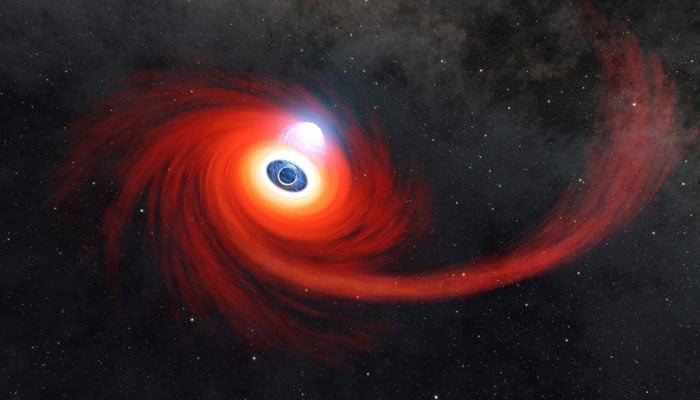Collision of black holes? Experts explain luminous cosmic burst
Black holes' gravitational pull is so potent that they rip apart everything that comes into their event horizon
June 14, 2023

A new study has attempted to answer a massive, luminous burst which was 100 times more radiant than our milky way in a galaxy named OJ287, located at a distance of five billion light years.
Scientists suggested this must have come from a system with two black holes.
The smaller one orbits, the larger one at around the speed of light. According to the study published in Monthly Notices of the Royal Astronomical Society, their spiral dance was responsible for luminosity.
The scientists noted that the recorded burst, observed in February last year, occurred when the smaller black hole crashed into a disk of gas surrounding the larger black hole.
These discs — also called accretion discs — are common in black holes, particularly in the supermassive black holes that are present at the centre of the giant galaxies.
Their gravitational pull is so potent that they rip apart everything that comes into their event horizon.

After falling into the large black hole, the smaller one swallows up some of the gas at the accreditation disc, which energises an explosive jet of radiation, ejecting from the smaller black hole.
The author Mauri Valtonen from the Tata Institute of Fundamental Research, in a statement: "According to the estimates, the flare occurred shortly after the smaller black hole had received a massive dose of new gas to swallow during its plunge."
Valtonen also added: "It is the swallowing process that leads to the sudden brightening of OJ287. It is thought that this process has empowered the jet which shoots out from the smaller black hole of OJ 287."
The event lasted for only a day.
"An event like this was predicted ten years ago, but has not been confirmed until now," Valtonen said.

He said: "It turns out that we have simply just had bad luck. Nobody observed OJ287 exactly on those nights when it did its one-night stunt."
The black holes are "so close to each other in the sky that one cannot see them separately, they merge to a single point in our telescopes," Valtonen noted.
Co-author of the study Achamveedu Gopakumar from the Tata Institute of Fundamental Research, said: "The total number of predicted flares now number 26, and nearly all of them have been observed.”
The study remarked that such explosions would continue to occur as the smaller black holes orbit the bigger ones, though they'll be irregular because the 12-year orbit is oblong.











